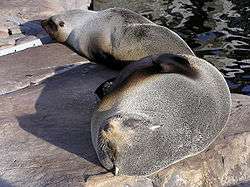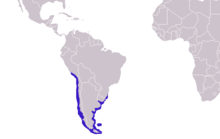South American fur seal
| South American fur seal | |
|---|---|
 | |
| South American fur seals at Bristol Zoo Gardens, England | |
| Scientific classification | |
| Kingdom: | Animalia |
| Phylum: | Chordata |
| Class: | Mammalia |
| Order: | Carnivora |
| Suborder: | Pinnipedia |
| Family: | Otariidae |
| Subfamily: | Arctocephalinae |
| Genus: | Arctocephalus |
| Species: | A. australis |
| Binomial name | |
| Arctocephalus australis (Zimmermann, 1783) | |
 | |
| Distribution of South American Fur Seal | |
The South American fur seal (Arctocephalus australis) breeds on the coasts of Chile, Peru, and Argentina, Uruguay and Brazil. The total population is around 250,000.
The population of South American fur seals in 1999 was estimated at 390,000, a drop from a 1987 estimate of 500,000. Although overall species numbers are healthy, the downward trend is causing some concern. Uruguay has the largest numbers of seals along its coast, numbering over 200,000.
Physical description
The South American fur seal has a dark grey coat of fur. The males of the species are almost entirely this color, though they may have grey or tan, grizzled markings. The females and subadult males have lighter grey or tan coloring on the chest and muzzle, and may have rust-brown or medium grey fur on their undersides. The muzzle is flat-topped and pointed, with a medium-sized nose. The nostrils are forward-facing and the nose extends past the mouth. The ear pinnae are long and prominent, and the vibrissae of adults are creamy white and of relatively short length. Adult males are larger than females, with thicker necks and larger shoulders. Males also develop manes of longer guard hairs on their heads and shoulders.[2] Size of the seals varies based on region, but on average, adult males measure up to 2 m long and weigh 150–200 kg and females measure up to 1.5 m long and weigh 30–60 kg.[3] Newborns are 60 to 65 cm and 3.5 to 5.5 kg.
Habitat
The South American fur seal is found on neotropical ocean coasts from the Paracas Peninsula of southern Peru south to Cape Horn on the Pacific coast, and northward to southern Brazil on the Atlantic coast. They are also found on the Falkland Islands, Staten Island, and Escondida Island.[4] A. australis seals prefer rocky shores and islands, particularly those with steep slopes, which provide shady areas where they can escape the heat of the sun. They have been found in sea caves in Peru, where some climb up to 15 m to find a spot to rest. There have been isolated records from continental Ecuador, the Galápagos Islands, and the Gorgona Island (Colombia). Anatomical information for the southern fur seals, Arctocephalus spp., is scant.[5]
Subspecies
Two subspecies are currently recognised:[6]
- A. a. australis - Falkland Islands
- A. a. gracilis - South America
The New Zealand fur seal is sometimes considered a subspecies of A. australis.[6]
References
- ↑ Campagna, C.; IUCN SSC Pinniped Specialist Group (2008). "Arctocephalus australis". IUCN Red List of Threatened Species. Version 2008. International Union for Conservation of Nature. Retrieved 14 January 2009.
- ↑ Marine Mammals > Species: Arctocephalus australis (South American fur seal)
- ↑ South American Fur Seal, Arctocephalus australis at MarineBio.org
- ↑ ADW: Arctocephalus australis: Information
- ↑ William Pérez, Helena Katz, Martin Lima. Gross heart anatomy of Arctocephalus australis (Zimmerman, 1783)Anatomical Science International (OnlineEarly Articles). doi:10.1111/j.1447-073X.2007.00189.x
- 1 2 Berta, A. & Churchill, M. (2012). "Pinniped Taxonomy: evidence for species and subspecies". Mammal Review. 42 (3): 207–234. doi:10.1111/j.1365-2907.2011.00193.x.
External links
| Wikimedia Commons has media related to Arctocephalus australis. |
- Fur seal preys on penguin
- Randall R. Reeves; Brent S. Stewart; Phillip J. Clapham; James A. Powell (2002). National Audubon Society Guide to Marine Mammals of the World. Alfred A. Knopf, Inc. ISBN 0375411410.
